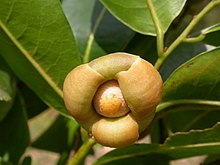Uvaria
Appearance
(Redirected from Balonga)
| Uvaria | |
|---|---|

| |
| U. chamae | |
| Scientific classification | |
| Kingdom: | Plantae |
| Clade: | Tracheophytes |
| Clade: | Angiosperms |
| Clade: | Magnoliids |
| Order: | Magnoliales |
| Family: | Annonaceae |
| Tribe: | Uvarieae |
| Genus: | Uvaria L.[1] |
| Species[2] | |
|
171; see text | |
| Synonyms[2] | |
| |
Uvaria is a genus of flowering plants in the family Annonaceae. The generic name uvaria is derived from the Latin uva meaning grape, likely because the edible fruit of some species in the genus resemble grapes.
Circumscription
[edit]Species are distributed throughout the Old World tropics.[3] This large genus had about 150 species,[3] and recent molecular analyses have revealed that several smaller genera belong within Uvaria, increasing its size.[4] 171 species are currently accepted.[2]
These are climbing shrubs or small trees. The flowers are borne singly, in pairs, or in small clusters. There are six petals in two whorls and many stamens.[3]
Selected species
[edit]

There are 171 accepted Uvaria species as of June 2024, according to Plants of the World Online.[2]
- Uvaria chamae P.Beauv. – Finger-root, China
- Uvaria dulcis Dunal - Tropical Asia (E. Indonesia, Jawa, Mainland Southeast Asia)
- Uvaria grandiflora Roxb. ex Hornem. - Indochina and Malesia
- Uvaria leichhardtii (F.Muell.) L.L.Zhou, Y.C.F.Su & R.M.K.Saunders – New Guinea and northern and eastern Australia
- Uvaria macclurei Diels – southern China
- Uvaria narum (Dunal) Wall. - Indian subcontinent
- Uvaria rufa (Dunal) Blume; Susung-kalabaw, Australia to Philippines & Indochina
- Uvaria siamensis (Scheff.) L.L.Zhou, Y.C.F.Su & R.M.K.Saunders – Indochina and Peninsular Malaysia
- Uvaria zeylanica L. - type species - India, Sri Lanka
Formerly placed here
[edit]- Kadsura japonica (L.) Dunal (as U. japonica L.)
- Cananga odorata (Lam.) Hook.f. & Thomson (as U. odorata Lam.)
- Oxandra lanceolata (Sw.) Baill. (as U. lanceolata Sw.)
- Huberantha cerasoides (Roxb.) Bedd. (as U. cerasoides Roxb.)
- Monoon longifolium (Sonn.) Thwaites (as U. longifolia Sonn.)
- Xylopia aromatica (Lam.) Mart. (as U. aromatica Lam.)[5][6]
References
[edit]- ^ Germplasm Resources Information Network (GRIN) (1996-09-17). "Genus: Uvaria L." Taxonomy for Plants. USDA, ARS, National Genetic Resources Program, National Germplasm Resources Laboratory, Beltsville, Maryland. Retrieved 2008-04-19.
- ^ a b c d "Uvaria L." Plants of the World Online. Royal Botanic Gardens, Kew. Retrieved 3 June 2024.
- ^ a b c Uvaria. Flora of China.
- ^ LinLin, Z., Su, Y. C. F., & Saunders, R. M. K. (2009). Molecular phylogenetic support for a broader delimitation of Uvaria (Annonaceae), inclusive of Anomianthus, Cyathostemma, Ellipeia, Ellipeiopsis and Rauwenhoffia. Systematics and Biodiversity, 7(3), 249-258.
- ^ Germplasm Resources Information Network (GRIN). "GRIN Species Records of Uvaria". Taxonomy for Plants. USDA, ARS, National Genetic Resources Program, National Germplasm Resources Laboratory, Beltsville, Maryland. Retrieved 2010-11-20.
- ^ "Uvaria L." Plants of the World Online. The Trustees of the Royal Botanic Gardens, Kew. n.d. Retrieved June 1, 2020.
